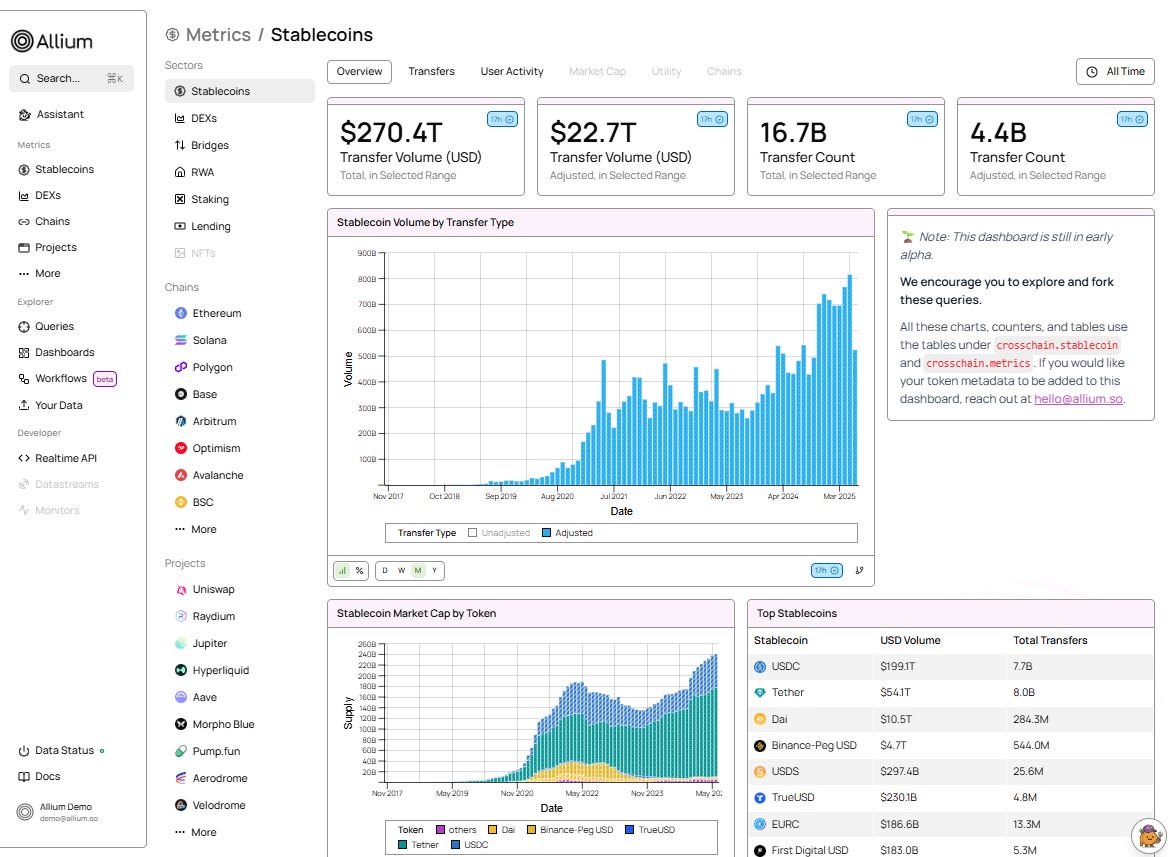Make-or-break in Alaska: why it matters
Plus: ETH's moment, Schwab's stablecoin, small businesses, "long crypto" + more
“There is no sun without shadow, and it is essential to know the night.” – Albert Camus ||
Hello everyone! I hope you’re all well. A long one today, and even so, a lot I had to leave out.
Production note: It’s a national holiday tomorrow where I live and this newsletter will skip publication day, but back with the free weekly on Saturday!
PUBLISHED IN PARTNERSHIP WITH: ✨ALLIUM✨
Allium provides blockchain data and analytics for institutions and fintechs, helping teams generate key insights from on-chain activity. Leaders like Visa, Stripe, and Grayscale rely on Allium to power mission-critical analyses and operations.
For more information: www.allium.so.
IN THIS NEWSLETTER:
Make-or-break in Alaska: why it matters
Schwab’s stablecoin: why?
Macro-Crypto Bits: ETH’s moment, “long crypto” is back, NFIB signals
If you’re not a premium subscriber, I hope you’ll consider becoming one! You get ~daily commentary on markets, tokenization, regulation and other signs that crypto IS impacting the macro landscape. As well as relevant links and music recommendations ‘cos why not.
WHAT I’M WATCHING:
Make-or-break in Alaska: why it matters
Tomorrow’s meeting in Alaska between President Trump and President Putin is likely to have a greater impact on the global economy (and therefore markets) than this week’s CPI, PPI and retail sales prints put together, whatever the outcome.
If a ceasefire is agreed, one that can be monitored and upheld, we are on the way to ending the war in Ukraine. That would be a very big deal for us here in Europe, where the daily devastation and death weighs heavy. Pretty much everyone on the continent, no matter where they live, has friends in Ukraine.
It would also be a huge deal in terms of economic and market outlook. Instead of pouring resources into a deadly stalemate, nations could focus on rebuilding. They could also turn their attention to much-needed investment in defence spending, which is perhaps not the most productive outlet (fighter jets and missiles, once made, hopefully just sit there) but which always tends to spin off ancillary tech development which does have productive civilian uses. And, peace even through deterrence has a dividend.
There will, of course, be political turmoil – possibly a change of government in Ukraine which could trigger further unrest, as well as greater fractures in an already divided Europe still reeling from diplomatic and economic blows delivered by both the US and China. But, unfortunately, deepening political turmoil is the base case on our continent anyway.
Of course, this is only if there is any agreement at all – there may not be, and the US is furiously downplaying expectations. It’s apparently just a “listening exercise”, as much as Trump wants to be seen as a peace broker. (It’s quite uncanny how the “US downplays” headlines are repeated across mainstream media.)
This may be one of the few occasions where Trump’s unpredictability is an asset. No change at all after the meeting would be a blow to his image and his ego, which we can assume would piss him off so much he would threaten hellfire, literally and figuratively. Amidst all the “downplaying” is a public warning of “very severe consequences” if no ceasefire agreement is reached. Trump must know by now that more sanctions won’t work, just as Putin knows that Trump won’t jeopardize the stability of the global oil market. And no-one wants to see the US directly get involved in the war, for fear of the retaliation.
But, Putin will probably calculate that the possibility of a really bad outcome makes a bad outcome look almost appealing. Russia will come across as having won the war, which is terrible and terrifying. But Ukraine is not in a position to win back lost territory, even with more help from Europe. And the killing has to end.
The Russian President has shown a disconcerting ability to handle Trump, making him feel successful while paying little attention to his demands. Remember how the war was going to end on “Day 1” of the Trump’s Administration? Since then, Russia has gained territory. Earlier today, the Financial Times reported that Putin was praising Trump’s “energetic and sincere efforts” to end the war – this is either resorting to the flatter-then-ignore strategy that has worked so far, or is a sign Putin might be willing to soften his demands tomorrow. One can hope.
International sentiment, judging by media reports, seems to be turning. It’s telling that yesterday the Financial Times ran a report titled “Russian breach sparks alarm on Ukraine’s eastern front”. When it comes to “mainstream” media, why we’re being told something is often more interesting than what we’re being told.
Speaking of which, European leaders today are whipping up media interviews insisting there is “unity” that no land will be ceded to Russia, and that everyone is in harmonious agreement. Yup, sure.
Historians throughout the ages have stressed that war is waged as much in the media as on the battlefield. So, as Alaska becomes the centre of global attention tomorrow, I’ll be paying less attention to the content of mainstream media reports, as to their intent.
Why this matters: Apart from the obvious benefits of an end to any military conflict, whatever happens next feeds into the “deep change” of geopolitics and economics that is sweeping the world. I’m still bewildered that we have smart economists and analysts clinging to previous patterns as a way to explain this one, including the “rates should be lower” crowd. Zooming out, yes, things can radically change, especially economic drivers. And one key symptom the world order is realigning? War. This one has been going on too long. We need to get on with picking up the pieces, and adjusting to a new power map.





